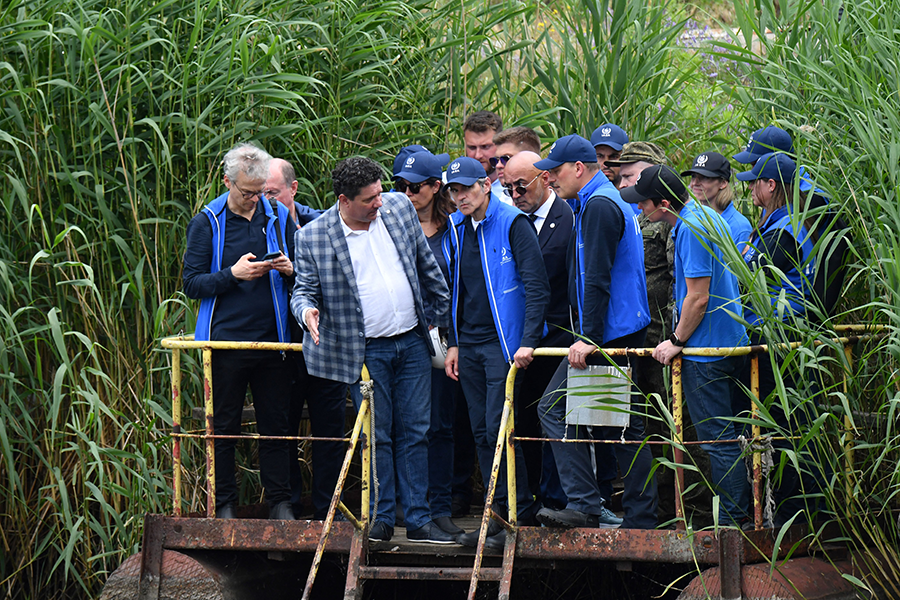IAEA Outlines Plan for Ukrainian Nuclear Reactor
July/August 2023
By Kelsey Davenport
The destruction of Ukraine’s Kakhovka Dam has raised fresh concerns about the safety of the Zaporizhzhia Nuclear Power Plant, even as the International Atomic Energy Agency (IAEA) advanced a new plan to protect the facility from Ukrainian and Russian fighting in the region.
An explosion caused the dam on the Dniep er River to fail on June 6. The dam is in Russian control, and imagery suggests that the explosion came from inside the structure. But Russia denied it was behind the destruction and blamed Ukraine.
er River to fail on June 6. The dam is in Russian control, and imagery suggests that the explosion came from inside the structure. But Russia denied it was behind the destruction and blamed Ukraine.
The reservoir created by the dam is the primary water source for cooling the Zaporizhzhia reactors to prevent a meltdown and for cooling the spent fuel. The pumps that pull water to the nuclear facility cannot operate if the reservoir falls below a certain level.
IAEA Director-General Rafael Mariano Grossi said on June 9 that there is no near-term risk that the plant will run short of water. He said the cooling pond on the site is full and will supply enough water “for months.”
After visiting the site on June 15, Grossi reiterated his assessment that there is no immediate danger, but said there is a need to “adapt the entire system” to the new water situation. He said that the plant managers are “taking concrete steps to address these challenges, stabilize the situation, and enable the plant to ensure sufficient cooling water also in the future.”
The plant came under Moscow’s control after Russian forces attacked the site in violation of international law early in the war, but it is still operated by Ukraine’s nuclear energy company, Energoatom. (See ACT, June 2022.)
The head of Energoatom, Petro Kotin, also said that there is no direct threat to the plant and that the cooling pond can be replenished from other sources, including mobile pumping units and underground drinking wells, if necessary.
But Grossi warned that although there is no “short-term threat,” the dam disaster is “causing major new difficulties” at a time when “the nuclear safety and security situation is already extremely fragile and potentially dangerous during the military conflict.”
During his trip, Grossi announced that the IAEA has expanded its permanent presence at the plant. Intensified fighting in the region “requires a strengthened IAEA presence,” he said.
Grossi sought for months to negotiate territorial protections for the plant before pivoting this year to a set of principles aimed at protecting it during conflict.
He presented the five principles he identified as “essential to avoid the danger of a catastrophic incident” to the UN Security Council during a May 30 meeting. The principles state that there should be no attack from or against the plant, particularly “targeting the reactors, spent fuel storage, other critical infrastructure, or personnel” and that heavy weapons and military personnel should not be based at the facility.
In addition, off-site power to the plant should be available and secure and not be put at risk; and the “structures, systems, and components” essential for safely and securely operating the facility should be protected from attacks and sabotage. Finally, Grossi proposed that “no action should be taken that undermines these principles” and “respectfully and solemnly” asked that Russia and Ukraine observe them. The IAEA team stationed at the plant will monitor implementation and report back to the agency, he added.
At the Security Council meeting, Russian Ambassador Vassily Nebenzia said that “ensuring nuclear safety and security” is an “overriding priority” for Russia. He described Grossi’s proposed principles as “consistent with measures” that Russia has been taking.
Nebenzia denied that any attacks were conducted “from the territory” of the plant and said heavy weaponry has never been deployed there.
But U.S. Ambassador Linda Thomas-Greenfield cited imagery released by the United Kingdom that showed “military emplacements atop reactors at the plant.”
Thomas-Greenfield said that Russia continues to “demonstrate flagrant disregard” for the objectives that Grossi laid out.
She said that if Russia wants to show it is “serious about reducing nuclear risk,” it can “remove its weapons and civil and military personnel” from the plant and return control to Ukraine.
It is “entirely within Moscow’s control to avert a nuclear catastrophe,” she said.
Ukrainian Ambassador Sergiy Kyslytsya said that Grossi’s principles must be accompanied by “full demilitarization and de-occupation” of the complex. Russia cannot be considered a “reliable partner,” given its violations of international treaties, he said.
